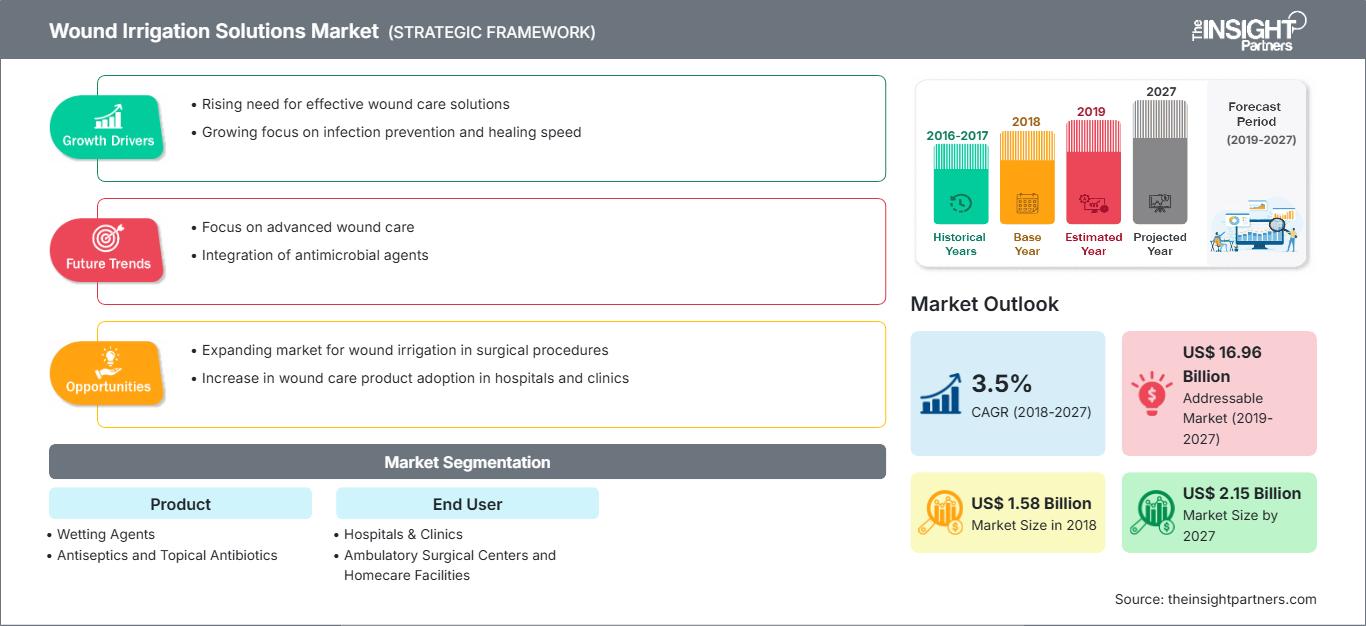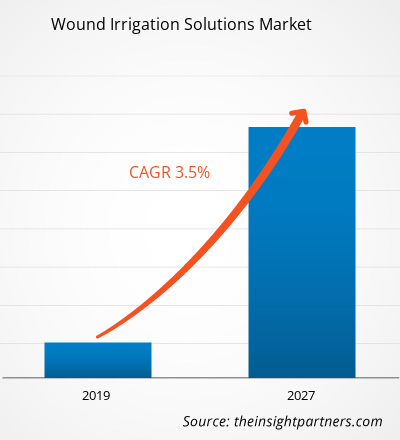El mercado de soluciones de irrigación de heridas se valoró en US$ 1.580,14 millones en 2018 y se proyecta que alcance los US$ 2.153,51 millones en 2027; se espera que crezca a una CAGR del 3,5% de 2019 a 2027.
La irrigación de heridas se refiere al proceso de pasar solución salina normal sobre una herida antes de su tratamiento. Las soluciones de irrigación ayudan a eliminar los restos celulares y los patógenos de la superficie de la herida. Son muy populares, ya que presentan menos efectos secundarios y ofrecen mejores resultados para erradicar el riesgo de una posible infección en la herida. El crecimiento del mercado mundial de soluciones de irrigación de heridas se atribuye al creciente número de accidentes de tráfico y casos de quemaduras. Sin embargo, la falta de reembolsos es el principal factor que frena el crecimiento del mercado.
Se espera que el mercado global de soluciones de irrigación de heridas experimente un crecimiento sustancial tras la pandemia. La COVID-19 ha afectado a las economías e industrias de varios países debido a confinamientos, prohibiciones de viaje y cierres de empresas. La crisis de la COVID-19 ha sobrecargado los sistemas de salud pública en muchos países y ha puesto de relieve la gran necesidad de inversión sostenible en ellos. A medida que la pandemia de COVID-19 avanza, se prevé que el sector sanitario experimente una caída en su crecimiento. El sector de las ciencias de la vida prospera gracias a la mayor demanda de productos de diagnóstico in vitro y al aumento de las actividades de investigación y desarrollo a nivel mundial. Sin embargo, el sector de las tecnologías médicas y la imagenología está experimentando una caída en las ventas debido a la menor cantidad de cirugías realizadas y a los retrasos o prolongaciones en la adquisición de equipos. Además, se prevé que las consultas virtuales de los profesionales sanitarios se conviertan en el modelo de atención sanitaria general tras la pandemia. Con la telesalud transformando la atención sanitaria, la salud digital seguirá prosperando en los próximos años. Asimismo, se espera que la interrupción de los ensayos clínicos y el consiguiente retraso en el lanzamiento de fármacos allanen el camino para ensayos totalmente virtuales en el futuro. Se espera que surjan nuevas tecnologías como el ARNm y transformen la industria farmacéutica y el mercado; también se espera que sea testigo de una mayor integración vertical y empresas conjuntas en los próximos años.
Recibirá personalización de cualquier informe, sin cargo, incluidas partes de este informe o análisis a nivel de país, paquete de datos de Excel, y además aprovechará grandes ofertas y descuentos para empresas emergentes y universidades.
Mercado de soluciones de irrigación de heridas: Perspectivas estratégicas

-
Obtenga las principales tendencias clave del mercado de este informe.Esta muestra GRATUITA incluirá análisis de datos, desde tendencias del mercado hasta estimaciones y pronósticos.
Perspectivas del mercado
El creciente número de accidentes de tráfico impulsará el crecimiento del mercado mundial de soluciones de irrigación de heridas.
Los accidentes de tránsito son los principales eventos traumáticos que impulsan el mercado de soluciones para la irrigación de heridas a nivel mundial. En todo el mundo, el tráfico y las carreteras son compartidos por automóviles, autobuses, camiones, motocicletas, ciclomotores, peatones, animales, taxis y otros medios de transporte. Según datos de los Centros para el Control y la Prevención de Enfermedades (CDC) publicados en 2016, las lesiones por accidentes de tránsito suponen una carga económica considerable para los países de ingresos bajos y medios. Por ejemplo, se estimó un costo aproximado de 518 000 millones de dólares estadounidenses a nivel mundial y de cerca de 65 000 millones de dólares estadounidenses en los países de ingresos bajos y medios.
Las lesiones por accidentes de tránsito causan fracturas óseas expuestas en diferentes partes del cuerpo. Otras afecciones que pueden causar lesiones incluyen parálisis de la médula espinal, traumatismos craneoencefálicos, desfiguración facial, lesiones en muñecas y brazos, entre otras. Para eliminar las bacterias de los tejidos contaminados, las lesiones se tratan primero con desbridamiento mediante la irrigación de la superficie de la herida con soluciones de irrigación. Actualmente, entre todas las soluciones de irrigación, la povidona yodada, la solución salina normal y la amikacina se utilizan ampliamente en los hospitales. Si se realiza correctamente, la irrigación de heridas puede mejorar la cicatrización al reducir la infección y sus morbilidades asociadas. La irrigación de heridas es una parte vital del tratamiento de heridas y es la intervención más importante en el cuidado de heridas que puede reducir el riesgo de infección. Por lo tanto, el aumento en la tasa de accidentes de tránsito contribuye al crecimiento del mercado de soluciones de irrigación de heridas en el período de pronóstico.
Perspectivas basadas en productos
En términos de producto, el mercado global de soluciones para la irrigación de heridas se segmenta en agentes humectantes, antisépticos y antibióticos tópicos. En 2018, el segmento de agentes humectantes tuvo la mayor participación de mercado. Sin embargo, se estima que el segmento de antisépticos crecerá a un ritmo más rápido durante el período de pronóstico.
Perspectivas regionales del mercado de soluciones de irrigación de heridas
Los analistas de The Insight Partners han explicado detalladamente las tendencias regionales y los factores que influyen en el mercado de soluciones de irrigación de heridas durante el período de pronóstico. Esta sección también analiza los segmentos y la geografía del mercado de soluciones de irrigación de heridas en América del Norte, Europa, Asia Pacífico, Oriente Medio y África, y América del Sur y Central.
Alcance del informe de mercado de soluciones de irrigación de heridas
| Atributo del informe | Detalles |
|---|---|
| Tamaño del mercado en 2018 | 1.580 millones de dólares estadounidenses |
| Tamaño del mercado en 2027 | US$ 2.15 mil millones |
| CAGR global (2018-2027) | 3,5% |
| Datos históricos | 2016-2017 |
| Período de pronóstico | 2019-2027 |
| Segmentos cubiertos |
Por producto
|
| Regiones y países cubiertos |
América del norte
|
| Líderes del mercado y perfiles de empresas clave |
|
Densidad de actores del mercado de soluciones de irrigación de heridas: comprensión de su impacto en la dinámica empresarial
El mercado de soluciones de irrigación de heridas está creciendo rápidamente, impulsado por la creciente demanda del usuario final debido a factores como la evolución de las preferencias del consumidor, los avances tecnológicos y un mayor conocimiento de los beneficios del producto. A medida que aumenta la demanda, las empresas amplían su oferta, innovan para satisfacer las necesidades del consumidor y aprovechan las tendencias emergentes, lo que impulsa aún más el crecimiento del mercado.

- Obtenga una descripción general de los principales actores clave del mercado de soluciones de irrigación de heridas
Información basada en el usuario final
En términos de usuario final, el mercado global de soluciones de irrigación de heridas se segmenta en hospitales y clínicas, centros de cirugía ambulatoria y centros de atención domiciliaria. El segmento de hospitales y clínicas tuvo la mayor participación de mercado en 2018, y se estima que este mismo segmento crecerá al ritmo más rápido durante el período de pronóstico.
Los actores del mercado global de soluciones de irrigación de heridas están adoptando estrategias de lanzamiento y expansión de productos para satisfacer las cambiantes demandas de los clientes en todo el mundo, lo que también les permite mantener su marca a nivel mundial.
Mercado global de soluciones de irrigación de heridas (por producto)
- Agentes humectantes
- Agentes tópicos
- Antisépticos
Mercado global de soluciones de irrigación de heridas (por usuario final)
- Hospitales y clínicas
- Centros de cirugía ambulatoria
- Centros de atención domiciliaria
Mercado global de soluciones de irrigación de heridas (por geografía)
-
América del norte
- A NOSOTROS
- Canadá
- México
-
Europa
- Francia
- Alemania
- Italia
- Reino Unido
- España
- Resto de Europa
-
Asia Pacífico (APAC)
- Porcelana
- India
- Corea del Sur
- Japón
- Australia
- Resto de APAC
-
Oriente Medio y África (MEA)
- Sudáfrica
- Arabia Saudita
- Emiratos Árabes Unidos
- Resto de MEA
-
América del Sur y América Central (SCAM)
- Brasil
- Argentina
- Resto de ESTAFA
Perfiles de empresas
- CR Bard (BD)
- B. Braun Melsungen AG
- Grupo ConvaTec PLC
- Schülke & Mayr (AIRE LÍQUIDO)
- Smith y sobrino
- NovaBay Pharmaceuticals, Inc
- Industrias Medline, Inc.
- Cardenal Health, Inc.
- Grupo Reckitt Benckiser plc.
- Grupo Coloplast
- Análisis histórico (2 años), año base, pronóstico (7 años) con CAGR
- Análisis PEST y FODA
- Tamaño del mercado, valor/volumen: global, regional y nacional
- Industria y panorama competitivo
- Conjunto de datos de Excel
Informes recientes
Informes relacionados
Testimonios
Razón para comprar
- Toma de decisiones informada
- Comprensión de la dinámica del mercado
- Análisis competitivo
- Información sobre clientes
- Pronósticos del mercado
- Mitigación de riesgos
- Planificación estratégica
- Justificación de la inversión
- Identificación de mercados emergentes
- Mejora de las estrategias de marketing
- Impulso de la eficiencia operativa
- Alineación con las tendencias regulatorias






















 Obtenga una muestra gratuita para - Mercado de soluciones para irrigación de heridas
Obtenga una muestra gratuita para - Mercado de soluciones para irrigación de heridas